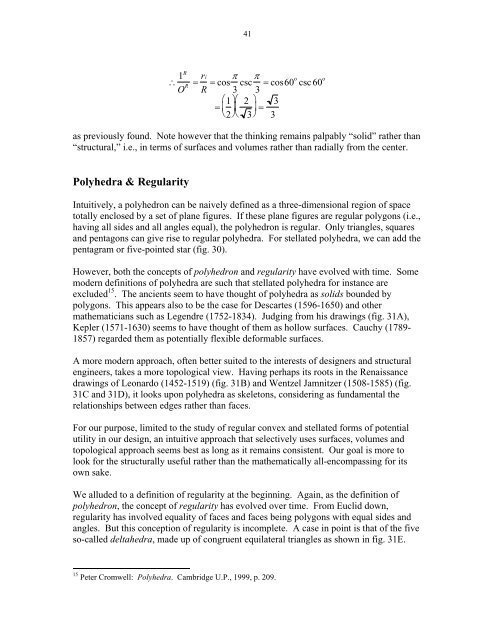Ad Quadratum Construction and Study of the Regular Polyhedra
Ad Quadratum Construction and Study of the Regular Polyhedra
Ad Quadratum Construction and Study of the Regular Polyhedra
Create successful ePaper yourself
Turn your PDF publications into a flip-book with our unique Google optimized e-Paper software.
1R<br />
O R ri<br />
R<br />
41<br />
<br />
cos csc<br />
3 3 cos60o csc 60 o<br />
1 <br />
<br />
2<br />
<br />
<br />
<br />
2 <br />
<br />
3<br />
3<br />
3<br />
as previously found. Note however that <strong>the</strong> thinking remains palpably “solid” ra<strong>the</strong>r than<br />
“structural,” i.e., in terms <strong>of</strong> surfaces <strong>and</strong> volumes ra<strong>the</strong>r than radially from <strong>the</strong> center.<br />
<strong>Polyhedra</strong> & <strong>Regular</strong>ity<br />
Intuitively, a polyhedron can be naively defined as a three-dimensional region <strong>of</strong> space<br />
totally enclosed by a set <strong>of</strong> plane figures. If <strong>the</strong>se plane figures are regular polygons (i.e.,<br />
having all sides <strong>and</strong> all angles equal), <strong>the</strong> polyhedron is regular. Only triangles, squares<br />
<strong>and</strong> pentagons can give rise to regular polyhedra. For stellated polyhedra, we can add <strong>the</strong><br />
pentagram or five-pointed star (fig. 30).<br />
However, both <strong>the</strong> concepts <strong>of</strong> polyhedron <strong>and</strong> regularity have evolved with time. Some<br />
modern definitions <strong>of</strong> polyhedra are such that stellated polyhedra for instance are<br />
excluded 15 . The ancients seem to have thought <strong>of</strong> polyhedra as solids bounded by<br />
polygons. This appears also to be <strong>the</strong> case for Descartes (1596-1650) <strong>and</strong> o<strong>the</strong>r<br />
ma<strong>the</strong>maticians such as Legendre (1752-1834). Judging from his drawings (fig. 31A),<br />
Kepler (1571-1630) seems to have thought <strong>of</strong> <strong>the</strong>m as hollow surfaces. Cauchy (1789-<br />
1857) regarded <strong>the</strong>m as potentially flexible deformable surfaces.<br />
A more modern approach, <strong>of</strong>ten better suited to <strong>the</strong> interests <strong>of</strong> designers <strong>and</strong> structural<br />
engineers, takes a more topological view. Having perhaps its roots in <strong>the</strong> Renaissance<br />
drawings <strong>of</strong> Leonardo (1452-1519) (fig. 31B) <strong>and</strong> Wentzel Jamnitzer (1508-1585) (fig.<br />
31C <strong>and</strong> 31D), it looks upon polyhedra as skeletons, considering as fundamental <strong>the</strong><br />
relationships between edges ra<strong>the</strong>r than faces.<br />
For our purpose, limited to <strong>the</strong> study <strong>of</strong> regular convex <strong>and</strong> stellated forms <strong>of</strong> potential<br />
utility in our design, an intuitive approach that selectively uses surfaces, volumes <strong>and</strong><br />
topological approach seems best as long as it remains consistent. Our goal is more to<br />
look for <strong>the</strong> structurally useful ra<strong>the</strong>r than <strong>the</strong> ma<strong>the</strong>matically all-encompassing for its<br />
own sake.<br />
We alluded to a definition <strong>of</strong> regularity at <strong>the</strong> beginning. Again, as <strong>the</strong> definition <strong>of</strong><br />
polyhedron, <strong>the</strong> concept <strong>of</strong> regularity has evolved over time. From Euclid down,<br />
regularity has involved equality <strong>of</strong> faces <strong>and</strong> faces being polygons with equal sides <strong>and</strong><br />
angles. But this conception <strong>of</strong> regularity is incomplete. A case in point is that <strong>of</strong> <strong>the</strong> five<br />
so-called deltahedra, made up <strong>of</strong> congruent equilateral triangles as shown in fig. 31E.<br />
15 Peter Cromwell: <strong>Polyhedra</strong>. Cambridge U.P., 1999, p. 209.




